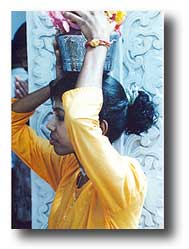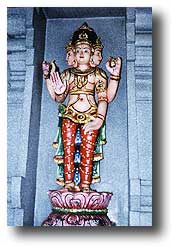நாத்திகனாம், கிருத்துவனாம், பௌத்தனாம், இன்று முகமதியனாம்!
இல்லை, முஸ்லீமாம், ஆமாம் அதுவும் பெயர் மாறுகிறது!
ஒரே மனித பிறவியலில் இப்படி பல கடவுளர்களை ஏமாற்றும் இவன் ஒரு “நம்பிக்கையாளனா?”
அத்தகைய மதமாறிகளை ஏற்கும் மதத்தின் கொள்கை என்ன?
Indian atheist embraces Islam

Dr. Periyadarshan, an Indian professor, became a Muslim at a Dawa center in Riyadh on Thursday. (AN Photo)
By MD RASOOLDEEN | ARAB NEWS
Published: Mar 12, 2010 23:25 Updated: Mar 13, 2010 18:14
http://arabnews.com/saudiarabia/article29180.eceRIYADH: A well-known Indian psychotherapist embraced Islam on Thursday.
Dr. Periyadarshan, who has changed his name to Abdullah, told Arab News Friday that Islam is the only religion in the world that follows a book directly revealed from God.
He said that as a student of comparative religions he believes books of other faiths have not been directly revealed to mankind from God. He said the Holy Qur’an is still in the same format and style as it was revealed to the Prophet Muhammed (pbuh) from Almighty Allah.
Dr. Abdullah is a visiting professor at the University of California in Los Angeles.
He also acted in the famous Tamil film “Karuthamma” about the killing of newborn baby girls in some remote villages in India. The production received national award from the Indian government.
“I was well known in India for my atheist theology and later I became to realize that religion is the only way out for human beings both in this world as well as in the hereafter,” he said.
Dr. Abdullah will be performing Umrah on Saturday on his first visit to the holy cities of Makkah and Madinah.
Thanks Vedaprakash


 ஈரோடு:கட்டாய மதமாற்றம் செய்ய முயன்றதாக துணை தாசில்தார் உட்பட ஆறு பேரை பொதுமக்கள் சிறை பிடித்த தால், ஈரோடு அருகே பரபரப்பு ஏற்பட்டது. அமெரிக்காவின் நியூயார்க்கை தலைமையிடமாகக் கொண்ட பைபிள் மாணாக்கர்கள் அமைப்பைச் சேர்ந்த சிலர், தனித்தனி குழுவாகப் பிரிந்து, ஈரோடு சூரியம்பாளையம் ஊராட்சி, சொட்டையம்பாளையம் பகுதியில் நேற்று மதப் பிரசாரத்தில் ஈடுபட்டனர். ரெவின்யூ காலனியில் வசிக்கும் கேசவன் வீட்டுக்கு நான்கு பேர் சென்றனர். அவரது வீட்டில் துண்டு பிரசுரங்கள் கொடுத்து, ‘மக்களாட்சி முடிவுறப் போகிறது; இனி தெய்வ ஆட்சி நடக்க உள்ளது.ஏசுவை பின்பற்றுபவர் மட்டுமே உலகில் நிலைத்திருப்பர்’ என்றனர்.அமைதியாக கேட்டுக் கொண்டிருந்த கேசவன், ‘பிரச்னை எதற்கு செய்கிறீர்கள்; ஊருக்குள் சென்றால் பிரச்னையாகி விடும், திரும்பச் செல்லுங்கள்’ என்றார்.
ஈரோடு:கட்டாய மதமாற்றம் செய்ய முயன்றதாக துணை தாசில்தார் உட்பட ஆறு பேரை பொதுமக்கள் சிறை பிடித்த தால், ஈரோடு அருகே பரபரப்பு ஏற்பட்டது. அமெரிக்காவின் நியூயார்க்கை தலைமையிடமாகக் கொண்ட பைபிள் மாணாக்கர்கள் அமைப்பைச் சேர்ந்த சிலர், தனித்தனி குழுவாகப் பிரிந்து, ஈரோடு சூரியம்பாளையம் ஊராட்சி, சொட்டையம்பாளையம் பகுதியில் நேற்று மதப் பிரசாரத்தில் ஈடுபட்டனர். ரெவின்யூ காலனியில் வசிக்கும் கேசவன் வீட்டுக்கு நான்கு பேர் சென்றனர். அவரது வீட்டில் துண்டு பிரசுரங்கள் கொடுத்து, ‘மக்களாட்சி முடிவுறப் போகிறது; இனி தெய்வ ஆட்சி நடக்க உள்ளது.ஏசுவை பின்பற்றுபவர் மட்டுமே உலகில் நிலைத்திருப்பர்’ என்றனர்.அமைதியாக கேட்டுக் கொண்டிருந்த கேசவன், ‘பிரச்னை எதற்கு செய்கிறீர்கள்; ஊருக்குள் சென்றால் பிரச்னையாகி விடும், திரும்பச் செல்லுங்கள்’ என்றார்.



 Hindus are found mainly in the nation of India, where over 90% of Hindus live. As well, there are large populations of Hindus in Nepal, Mauritius, Fiji, Guyana, Suriname, Bangladesh, Malaysia, Trinidad and Tabago, and Bhutan.
Hindus are found mainly in the nation of India, where over 90% of Hindus live. As well, there are large populations of Hindus in Nepal, Mauritius, Fiji, Guyana, Suriname, Bangladesh, Malaysia, Trinidad and Tabago, and Bhutan. Different “ways” have developed over the history of Hinduism, Vedic Hinduism being the oldest, and then the ascetic and mystical way known as Vedantic Hinduism, and more recently the way of devotion, or Bhakti.
Different “ways” have developed over the history of Hinduism, Vedic Hinduism being the oldest, and then the ascetic and mystical way known as Vedantic Hinduism, and more recently the way of devotion, or Bhakti. The oldest and most revered holy writings are the Vedas, consisting of four books or more correctly--collections. They are the Rig Veda, Sama Veda, Yajur Veda, and Atharva Veda. These are sacrificial hymns, chants, rituals and explanations. In addition to the Vedas, numerous other writings have been added through the years. These include the Upanishads, which are multiple in number, ten being most important. The common topics are: states of consciousness, dreams, meditations, self-realization (that you are divine), and the unity of all things. Then there are the Darshanas, with six major schools or Philosophical systems and teachings developed out of the Vedas: Nyaga, Mimamsa, Vaiseshika, Yoga, Samkhya, and Vendata.
The oldest and most revered holy writings are the Vedas, consisting of four books or more correctly--collections. They are the Rig Veda, Sama Veda, Yajur Veda, and Atharva Veda. These are sacrificial hymns, chants, rituals and explanations. In addition to the Vedas, numerous other writings have been added through the years. These include the Upanishads, which are multiple in number, ten being most important. The common topics are: states of consciousness, dreams, meditations, self-realization (that you are divine), and the unity of all things. Then there are the Darshanas, with six major schools or Philosophical systems and teachings developed out of the Vedas: Nyaga, Mimamsa, Vaiseshika, Yoga, Samkhya, and Vendata. Places of worship are everywhere for Hindus. Shrines and temples are common in India and wherever Hindus live. The most basic place of worship for Hindus is the home shrine in which a person's individual personal gods are worshipped or the family's gods are worshipped. An individual will often keep their gods and pictures on a small shelf or alcove. The family gods will often have a designated place of the house for worship; in wealthier homes it may even be a room of the house.
Places of worship are everywhere for Hindus. Shrines and temples are common in India and wherever Hindus live. The most basic place of worship for Hindus is the home shrine in which a person's individual personal gods are worshipped or the family's gods are worshipped. An individual will often keep their gods and pictures on a small shelf or alcove. The family gods will often have a designated place of the house for worship; in wealthier homes it may even be a room of the house.
 The first one is that Jesus was one of the incarnations (avatars) of God. Most Hindus believe that God, specifically Vishnu, took on human or animal forms at various times in order to perform certain feats that would preserve true Hindu teaching (the dharma). In this context, then, it has been argued that Jesus, along with Rama, Krishna, and others, was just one more divine self-embodiment. Whereas Christians generally believe that Jesus was the one and only incarnation of God, this view would hold that he was an incarnation, just not the only one.
The first one is that Jesus was one of the incarnations (avatars) of God. Most Hindus believe that God, specifically Vishnu, took on human or animal forms at various times in order to perform certain feats that would preserve true Hindu teaching (the dharma). In this context, then, it has been argued that Jesus, along with Rama, Krishna, and others, was just one more divine self-embodiment. Whereas Christians generally believe that Jesus was the one and only incarnation of God, this view would hold that he was an incarnation, just not the only one. Hinduism prides itself on its tolerance of many different approaches to religion, and, consequently, there is a great amount of diversity in beliefs and practices. In fact, it is probably not unfair to say that in order to be a Hindu it is not as important to believe or do certain things as it is to fit into the basic cultural patterns that include veneration of the Vedas (the scriptures), the caste system, and cow protection.
Hinduism prides itself on its tolerance of many different approaches to religion, and, consequently, there is a great amount of diversity in beliefs and practices. In fact, it is probably not unfair to say that in order to be a Hindu it is not as important to believe or do certain things as it is to fit into the basic cultural patterns that include veneration of the Vedas (the scriptures), the caste system, and cow protection. Christian missions to Hindus goes back to some of the earliest times of the church. According to an ancient tradition, the apostle Thomas was the first to carry the gospel to India, and there were some sporadic efforts to establish a church in India prior to the classical missions era, which dovetailed the colonial period.
Christian missions to Hindus goes back to some of the earliest times of the church. According to an ancient tradition, the apostle Thomas was the first to carry the gospel to India, and there were some sporadic efforts to establish a church in India prior to the classical missions era, which dovetailed the colonial period.


